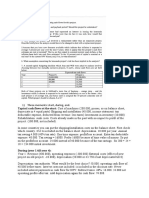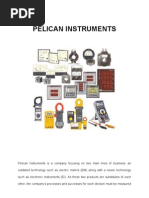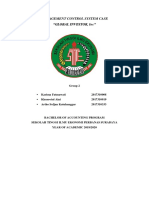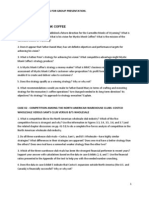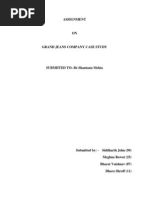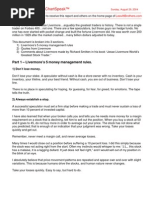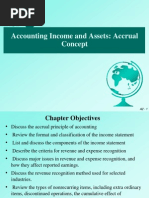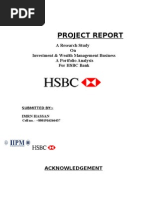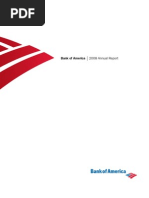Catalytic Solutions Inc
Catalytic Solutions Inc
Uploaded by
david davidsonCopyright:
Available Formats
Catalytic Solutions Inc
Catalytic Solutions Inc
Uploaded by
david davidsonOriginal Title
Copyright
Available Formats
Share this document
Did you find this document useful?
Is this content inappropriate?
Copyright:
Available Formats
Catalytic Solutions Inc
Catalytic Solutions Inc
Uploaded by
david davidsonCopyright:
Available Formats
Catalytic Solutions, Inc.
There are pros and cons regarding the CSI performance measurement and compensation systems.
The pros are as followed. First, the compensation system was both long term and short term
measures. The company combined non-financial and financial measures in order to overcome the myopia
problem. Second, the bonuses were based on the overall performance of the company. This incentive
would encourage employees to work together as a team and foster commitment to overall cooperate
goals. Third, the CSI limited the performance indicators to the range of 4-6. In 2002, the CSI had four
performance areas. This new list of measures presented to the employees about the priorities they should
be focusing on. Fourth, the bonus assignments ranged from 0%-215% of the target amounts. And in the
quality area, the bonus assignment ranged from minus 15% to plus 20%. Having the upper and lower
cutoffs would avoid paying bonuses for performance which is considered bad or worse and maintain
vertical compensation equity.
The cons are as followed. First, the base salary was slightly below the average. And the target
bonus was only 5-10% of an employees base salary. This annual bonus might not be valued and have
impact on the employees since the reward amount was quite small. My recommendation is to increase the
target bonus to 15-30% of the employees base salary. Second, the building infrastructure area liked to
bonus awards had a relatively small percentage. But obtaining QS-14001 certification was a major
challenge for the CSI. So in order to motivate employees, my suggestions is to assign 40% to the building
infrastructure area instead of 20% to create big impact on the employees; and we could shrink the OE
commitments to 85% since managers only identified the programs whereas top executives made the final
decisions. Third, the company was expanding and would possibly go public in the near future. All
bonuses were awarded based on corporate, not individual was not objective and fair enough for a large
company. I suggest an individual performance rewarding system that is congruent with cooperate goals.
For the stock options, the advantages are listed below. First, the company provided incentive
compensation without cash outlay. Second, this long term incentive component could create company
loyalty. Third, giving stock options to employees would motivate them to increase their companys stock
price. For example, by 2002, employees had an average accumulated value in stock option worth 50% of
their annual salary. Here are the disadvantages. First, the stock option might motivate managers not do
take risker projects which could increase stock price volatility. Second, the stock option might also
generate windfall compensation. The stock price might rise because of the market condition, not because
the managers and the lower level employees did an excellent job. Third, the company was planning to go
public, so there was a chance that the company didnt go public or the stock price went underwater. This
situation would definitely have a reverse effect on employee motivation.
For the annual bonus plan, the advantages are listed below. First, this short term incentive would
have a direct impact on the employees. Second, this plan would encourage employees to be focused on
short-term gain and work together as a team. Here are the disadvantages. First, the bonus was determined
only based on the cooperate performance. Individual employee would feel unfair because some of the
objectives were out of their control. Second, the amount of rewards was not large enough to have big
impact on employees. Third, the plan might create some tax issues for the company.
You might also like
- 2024 FRM Part II PE1Document154 pages2024 FRM Part II PE1ROHAN KUMAR100% (1)
- Financial Reporting First Take - Ron KingDocument340 pagesFinancial Reporting First Take - Ron KingYuan Fu100% (1)
- Group6 - Vyaderm PharmaceuticalsDocument7 pagesGroup6 - Vyaderm PharmaceuticalsVaishak AnilNo ratings yet
- Business Analysis and Valuation IFRS Edition 3rd Ed - RemovedDocument48 pagesBusiness Analysis and Valuation IFRS Edition 3rd Ed - RemovedAthira Khairunnisa100% (1)
- Catalytic Solutions, Inc.Document1 pageCatalytic Solutions, Inc.Xin GongNo ratings yet
- Management Control Systems in Early StageDocument33 pagesManagement Control Systems in Early StageBryan BlanchotNo ratings yet
- Typical Cash Flows at The Start: Cost of Machines (200.000, Posses, So On Balance SheetDocument7 pagesTypical Cash Flows at The Start: Cost of Machines (200.000, Posses, So On Balance SheetSylvan EversNo ratings yet
- Performance Management System at Attock Refinery Limited: Group 4 Team PlasterDocument15 pagesPerformance Management System at Attock Refinery Limited: Group 4 Team PlasterMaryum KasbatiNo ratings yet
- Canadian Securities Course Volume One Supplemental QuestionsDocument140 pagesCanadian Securities Course Volume One Supplemental QuestionsTrần Huỳnh Thanh Bình0% (1)
- Hilton Chapter 13 SolutionsDocument71 pagesHilton Chapter 13 SolutionsSharkManLazersNo ratings yet
- Mcs PelicanDocument6 pagesMcs PelicanJasmina Stanojevich100% (1)
- Global InvestorsDocument36 pagesGlobal InvestorsIda Agustini50% (2)
- Netflix, Inc.-The Mouse Strikes Back SolutionDocument1 pageNetflix, Inc.-The Mouse Strikes Back SolutionArhamNo ratings yet
- Final Draft - MFIDocument38 pagesFinal Draft - MFIShaquille SmithNo ratings yet
- Summary A Survey of Corporate Governance by Shleifer VishnyDocument61 pagesSummary A Survey of Corporate Governance by Shleifer VishnyAlayou Tefera100% (1)
- 7 1 Haengbok Bancorp RZDocument4 pages7 1 Haengbok Bancorp RZAnatasyaOktavianiHandriatiTataNo ratings yet
- Chap 028Document12 pagesChap 028Rand Al-akam100% (1)
- Case Study On Solartronics, IncDocument3 pagesCase Study On Solartronics, IncSrishti Wadhwa100% (2)
- Case 5-1&5-4Document3 pagesCase 5-1&5-4Tiffany SmithNo ratings yet
- Fit Food Inc.: Case ReportDocument10 pagesFit Food Inc.: Case ReportHHHHHHEAMAYNo ratings yet
- Corporate Governance Difference Between Theories and ModelDocument8 pagesCorporate Governance Difference Between Theories and ModelCh Ahsan Ali KhanNo ratings yet
- Case19-4 Landau CompanyDocument1 pageCase19-4 Landau Companysaberrz0% (1)
- Chapter Five Decision Making and Relevant Information Information and The Decision ProcessDocument10 pagesChapter Five Decision Making and Relevant Information Information and The Decision ProcesskirosNo ratings yet
- Birch Paper Company Case Study SolutionsDocument3 pagesBirch Paper Company Case Study Solutionsmina hannaNo ratings yet
- Case SPMDocument4 pagesCase SPMainiNo ratings yet
- PHT and KooistraDocument4 pagesPHT and KooistraNilesh PrajapatiNo ratings yet
- Zumwald AG Case TextDocument2 pagesZumwald AG Case TextSilvester Dark Slayer100% (1)
- Transcript of Untitled PreziDocument5 pagesTranscript of Untitled PreziravikashNo ratings yet
- Solartronics IncDocument5 pagesSolartronics Incraman2303100% (2)
- Chapter 18Document17 pagesChapter 18queen hassaneenNo ratings yet
- Case Study 5Document3 pagesCase Study 5Farhanie NordinNo ratings yet
- New Jersey Insurance CompanyDocument13 pagesNew Jersey Insurance CompanyParth V. PurohitNo ratings yet
- Case Questions - EssentialsDocument9 pagesCase Questions - EssentialsHarry KingNo ratings yet
- C Law T2Document5 pagesC Law T2hudaNo ratings yet
- Solved - United Technologies Corporation (UTC), Based in Hartfor...Document4 pagesSolved - United Technologies Corporation (UTC), Based in Hartfor...Saad ShafiqNo ratings yet
- Case Study-Group 9Document4 pagesCase Study-Group 9Beto SiahaanNo ratings yet
- Case 4.2 Comptronic CorporationDocument2 pagesCase 4.2 Comptronic CorporationThao NguyenNo ratings yet
- Task Report On Financial Modelling ModuleDocument22 pagesTask Report On Financial Modelling ModuleLa Ode SabaruddinNo ratings yet
- HomeWork MCS-Nurul Sari (1101002048) - Case 5.1 5.4Document5 pagesHomeWork MCS-Nurul Sari (1101002048) - Case 5.1 5.4Nurul SariNo ratings yet
- I&c 2Document6 pagesI&c 2AleksandraNo ratings yet
- Introduction of Corporate Governance: VisionDocument5 pagesIntroduction of Corporate Governance: VisionVenu VijayNo ratings yet
- 5 PorterDocument10 pages5 PorterkulsoomalamNo ratings yet
- © 2012 Pearson Prentice Hall. All Rights ReservedDocument28 pages© 2012 Pearson Prentice Hall. All Rights ReservedRaktimNo ratings yet
- Case-Study - Private FitnessDocument4 pagesCase-Study - Private FitnessIndustry ReportNo ratings yet
- Worthington Industries Case 12-3Document6 pagesWorthington Industries Case 12-3jim_mcdiarmid1100% (1)
- Grand Jeans CaseDocument6 pagesGrand Jeans Casebharat1010No ratings yet
- Presented By: Ishan Aggarwal Manju Chandel Rajat SinglaDocument26 pagesPresented By: Ishan Aggarwal Manju Chandel Rajat Singlarajat_singla100% (3)
- LandauDocument8 pagesLandauJenny Joy SedigoNo ratings yet
- Case 2.2 and 2.5 AnswersDocument4 pagesCase 2.2 and 2.5 AnswersHeni OktaviantiNo ratings yet
- Whiz Calculator CompanyDocument18 pagesWhiz Calculator CompanyAsibur Rahman100% (1)
- Assignment 2 BRMDocument4 pagesAssignment 2 BRMtalha100% (3)
- HorngrenIMA14eSM ch10Document66 pagesHorngrenIMA14eSM ch10Zarafshan Gul Gul MuhammadNo ratings yet
- Case Enager IndustriesDocument4 pagesCase Enager IndustriesNikko Sucahyo50% (2)
- Case #2 NIKE INCDocument6 pagesCase #2 NIKE INCSamantha LunaNo ratings yet
- Nestle-Organizational Behaviour With Refrence To 17 PointsDocument9 pagesNestle-Organizational Behaviour With Refrence To 17 PointsKhaWaja HamMadNo ratings yet
- Volkswagen Report (Pan Sin Yi)Document7 pagesVolkswagen Report (Pan Sin Yi)janeNo ratings yet
- SfdfdsDocument4 pagesSfdfdsDominikCampanellaNo ratings yet
- Cost Of Capital A Complete Guide - 2020 EditionFrom EverandCost Of Capital A Complete Guide - 2020 EditionRating: 4 out of 5 stars4/5 (1)
- Corporate Financial Analysis with Microsoft ExcelFrom EverandCorporate Financial Analysis with Microsoft ExcelRating: 5 out of 5 stars5/5 (1)
- Growth Strategy Process Flow A Complete Guide - 2020 EditionFrom EverandGrowth Strategy Process Flow A Complete Guide - 2020 EditionNo ratings yet
- SEBI ActDocument2 pagesSEBI ActPankaj2c100% (1)
- Derivatives MarketDocument12 pagesDerivatives MarketShushmita SoniNo ratings yet
- BMA 12e SM CH 16 FinalDocument15 pagesBMA 12e SM CH 16 Finalmandy YiuNo ratings yet
- Jesse LivermoreDocument9 pagesJesse Livermoreapi-3707909100% (3)
- Taxation - Paper T5Document20 pagesTaxation - Paper T5Kabutu ChuungaNo ratings yet
- MutualDocument92 pagesMutualYogi173No ratings yet
- Campus BuzzDocument2 pagesCampus BuzzHarveyNo ratings yet
- Chapter 2 (Accounting Income Ans Assets - The Accrual Concept)Document32 pagesChapter 2 (Accounting Income Ans Assets - The Accrual Concept)Tonoy Roy75% (4)
- Bản Sao Của 22040291 - Lê Bảo Linh Đan - English for Finance and Banking Case Study 3Document12 pagesBản Sao Của 22040291 - Lê Bảo Linh Đan - English for Finance and Banking Case Study 3qainparis77No ratings yet
- Beaver W 1968 The Information Content of Annual Earnings AnnouncementsDocument15 pagesBeaver W 1968 The Information Content of Annual Earnings AnnouncementsYuvendren LingamNo ratings yet
- G3 (Akash Ingale) PEM PFSDocument7 pagesG3 (Akash Ingale) PEM PFSNirank JadhavNo ratings yet
- Bond and Stock ValuationDocument14 pagesBond and Stock ValuationadikopNo ratings yet
- Dhaka Bank Annual Report 2023Document408 pagesDhaka Bank Annual Report 2023Tuhin ChowdhuryNo ratings yet
- Lý Thuyết Corporation Law FullDocument33 pagesLý Thuyết Corporation Law FullÁnh Minh NguyễnNo ratings yet
- EGM NoticeDocument10 pagesEGM NoticeAravinth ARNo ratings yet
- Taxation Law 1111111Document10 pagesTaxation Law 1111111SpidermanNo ratings yet
- Payout PolicyDocument4 pagesPayout Policyannie:XNo ratings yet
- Technip SA v. SMS Holding (P) Ltd. & Ors. Case AnalysisDocument4 pagesTechnip SA v. SMS Holding (P) Ltd. & Ors. Case AnalysisMahak ChhabraNo ratings yet
- SA Listed Property 20140416 053216007Document13 pagesSA Listed Property 20140416 053216007Farai MwamukaNo ratings yet
- InvestmentDocument48 pagesInvestmentRheu ReyesNo ratings yet
- HBS - Pitcairn Family Heritage (R) Fund PDFDocument16 pagesHBS - Pitcairn Family Heritage (R) Fund PDFAngelo LauriNo ratings yet
- Internship Report On HSBCDocument78 pagesInternship Report On HSBCM I HASSANNo ratings yet
- Media of FinanceDocument191 pagesMedia of FinanceNilam PatelNo ratings yet
- DRHP CSLDocument460 pagesDRHP CSLSubscriptionNo ratings yet
- 018 - BoA 2008 - ARDocument195 pages018 - BoA 2008 - ARelivislives100% (1)
- Stock Price Prediction Using The ARIMA ModelDocument7 pagesStock Price Prediction Using The ARIMA ModelAman KediaNo ratings yet






